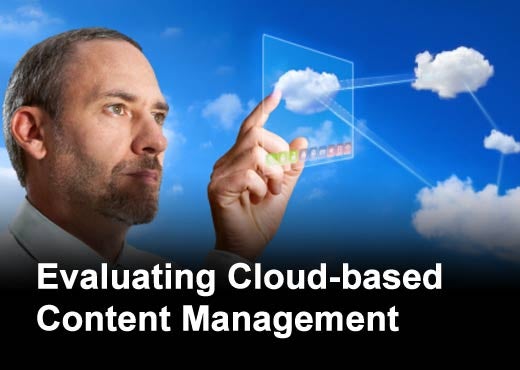When deploying an enterprise content management (ECM) solution, the cloud model can provide tremendous advantages over traditional on-premise software implementations. To determine if the cloud model offers the best option for your business, SpringCM has developed five considerations that can help you frame your discussions, consider your options, and make your decision.
Click through for five issues you should consider when moving toward an enterprise content management system, as outlined by SpringCM.
The cloud model is a pay-for-what-you-use option. As a per user subscription service, the business avoids the intensive capital investments for hardware and license costs that an on-premise software application requires. With cloud options, it is not unusual to gain real business value in less time than it takes to gain approval for the capital expenditure request for on-premise software.
Cloud can reduce project risk for document management and workflow applications such as collaboration, invoice automation, contract management and case management. This is because the technology platform is in place and requires configuration rather than assembly. In addition, the team can focus on the business process and not on IT plumbing. On an on-going basis, using the cloud or SaaS model can actually reduce business risk because it creates greater business agility.
With a cloud platform, upgrades occur every 10–12 weeks. Because of its rapid evolution, customer business processes can evolve rapidly as well, which can enable a transformative environment. Because you also don’t have to worry about hardware, customized software, and middleware, you can focus on running the business. In addition, a cloud ECM platform can be extensively tailored to meet business needs through configuration, rather than costly programming. As your business needs to change, a cloud solution can change with it, which makes a cloud ECM solution much more of a transformative solution.
Solving a typical content management business problem requires the integration of multiple technologies like document management, workflow, scanning, capture and e-mail management as well as other tools and technologies. An on-premise software application requires you to install and implement all of these as well as the software.
With extensive Web services, cloud platforms allow trouble-free integration between other cloud platforms (such as Salesforce.com), existing on-premise applications (such as Microsoft SharePoint and ERP applications), an organization’s identity management system, and with parties outside the organization (such as vendors, customers, partners, suppliers, and franchisees). In fact, many of today's more valuable content applications work externally in collaboration with customers, partners, vendors, and others outside the organization. Why? Because cloud requires no special integration or programming to provide a secure space to share documents and get work done.
To earn the trust of enterprise customers, a cloud ECM platform must demonstrate the strictest security standards, such as a SAS 70 Type II certified environment. A best-practice provider will use SAS 70 Type II certification as a base and build on that with additional security and technologies. While on-premise solutions enjoy the benefits of in-house security, in some cases internal IT budgets and resources will be unable to compete with this level of security. Cloud platforms can also typically integrate with an organization’s identity management technology through things like SSO and directory synchronization.








